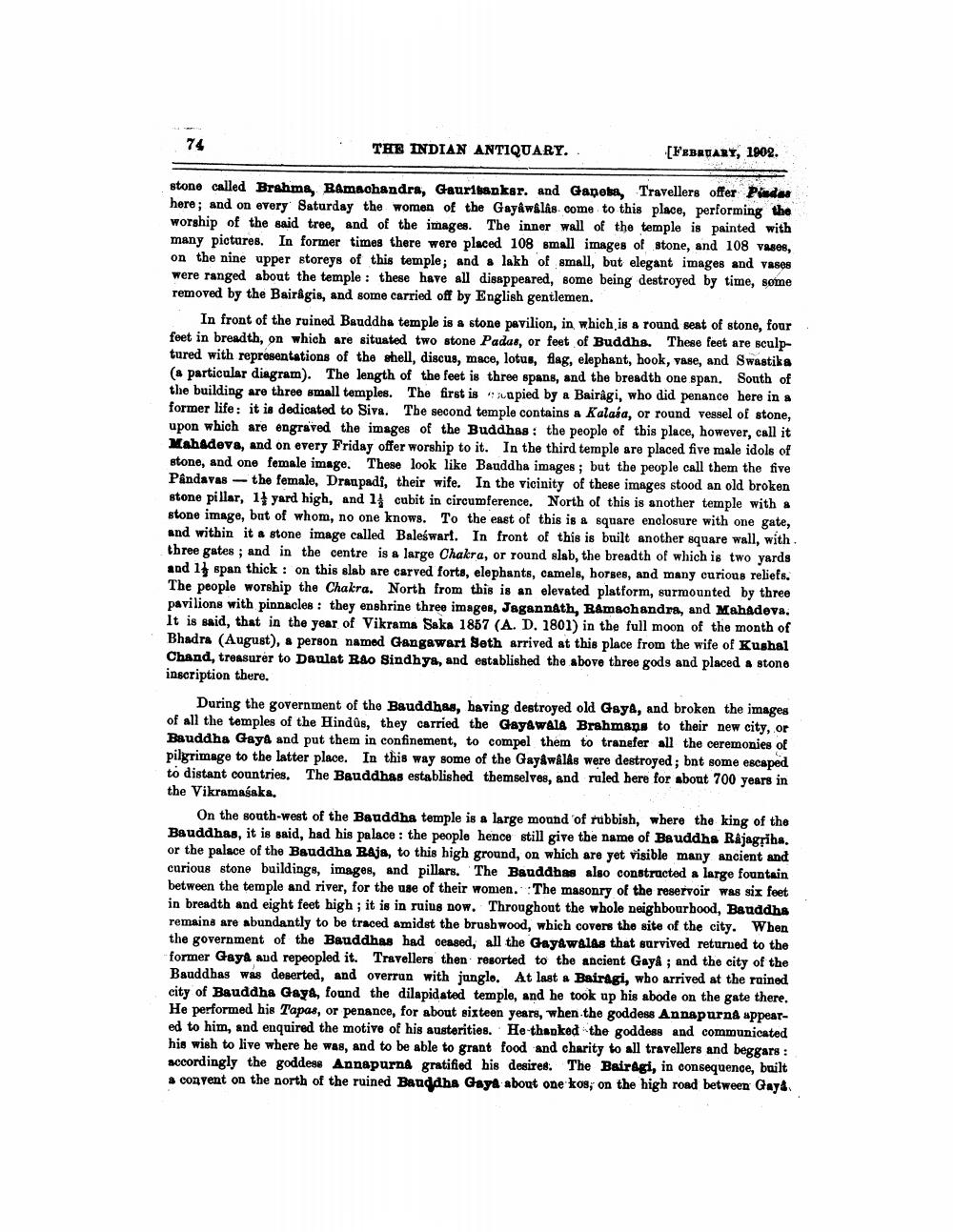________________
74
THE INDIAN ANTIQUARY. .
[FEBRDARY, 1902.
stone called Brahms, Ramachandra, Gaurikanker. and Ganeta, Travellers offer Pinder here, and on every Saturday the women of the Gayâwâlâs come to this place, performing the worship of the said tree, and of the images. The inner wall of the temple is painted with many pictures. In former times there were placed 108 small images of stone, and 108 vases, on the nine upper storeys of this temple; and a lakh of small, but elegant images and vases were ranged about the temple : these have all disappeared, some being destroyed by time, some removed by the Bairagis, and some carried off by English gentlemen.
In front of the ruined Bauddha temple is a stone pavilion, in which is a round seat of stone, four feet in breadth, on which are situated two stone Padas, or feet of Buddhs. These feet are sculptured with representations of the shell, discus, mace, lotus, flag, elephant, hook, vase, and Swastika (8 particular diagram). The length of the feet is three spans, and the breadth one span. South of the building are three small temples. The first is apied by a Bairagi, who did penance here in a former life: it is dedicated to Siva. The second temple contains a Kalaia, or round vessel of stone, upon which are engraved the images of the Buddhas: the people of this place, however, call it Mahadeva, and on every Friday offer worship to it. In the third temple are placed five male idols of stone, and one female image. These look like Bauddha images ; but the people call them the five Pandavas - the female, Draupadi, their wife. In the vicinity of these images stood an old broken stone pillar, 11 yard high, and 14 cubit in circumference. North of this is another temple with a stone image, but of whom, no one knows. To the east of this is a square enclosure with one gate, and within it & stone image called Baleswart. In front of this is built another square wall, with three gates; and in the centre is a large Chakra, or round slab, the breadth of which is two yards and 1} span thick : on this slab are carved forts, elephants, camels, horses, and many curious reliefs. The people worship the Chakra. North from this is an elevated platform, surmounted by three pavilions with pinnacles: they enshrine three images, Jagannath, Ramachandra, and Mahadeva. It is said, that in the year of Vikrams Saka 1857 (A. D. 1801) in the full moon of the month of Bhadra (August), a person named Gangawart Seth arrived at this place from the wife of Kushal Chand, treasurer to Daulat RAO Sindhya, and established the above three gods and placed a stone inscription there.
During the government of the Bauddhas, having destroyed old Gaya, and broken the images of all the temples of the Hindus, they carried the Gayawala Brahmans to their new city, or Bauddha Gaya and put them in confinement, to compel them to transfer all the ceremonies of pilgrimage to the latter place. In this way some of the Gayâwâlâs were destroyed; bnt some escaped to distant countries. The Bauddhas established themselves, and ruled here for about 700 years in the Vikramasaka.
On the south-west of the Bauddha temple is a large mound of rubbish, where the king of the Bauddhas, it is said, had his palace : the people hence still give the name of Bauddha Rajagriha. or the palace of the Bauddha Baja, to this high ground, on which are yet visible many ancient and curious stone buildings, images, and pillars. The Bauddhas also constructed a large fountain between the temple and river, for the use of their women. The masonry of the reservoir was six feet in breadth and eight feet high; it is in ruius now. Throughout the whole neighbourhood, Bauddha remains are abundantly to be traced amidst the brushwood, which covers the site of the city. When the government of the Bauddhas had ceased, all the Gayawalls that survived returned to the former Gaya aud repeopled it. Travellers then resorted to the ancient Gayâ ; and the city of the Bauddhas was deserted, and overrun with junglo. At last a Bairagi, who arrived at the ruined city of Bauddha Gaye, found the dilapidated temple, and he took up his abode on the gate there. He performed his Tapas, or penance, for about sixteen years, when the goddess Annapurna appeared to him, and enquired the motive of his austerities. He-thanked the goddess and communicated his wish to live where he was, and to be able to grant food and charity to all travellers and beggars : accordingly the goddess Annapurna gratified his desires. The Bairagi, in consequence, built * convent on the north of the ruined Bauddha Gaya about one kos; on the high road between Gaya




